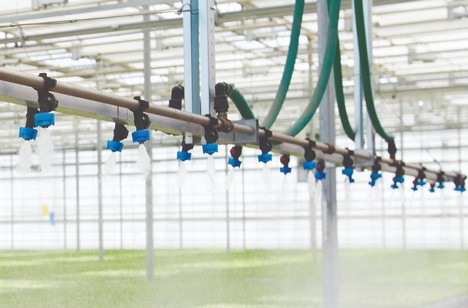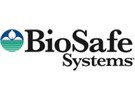Eric Smith of BioSafe Systems advises growers not to be “out of sight and out of mind” when it comes to greenhouse irrigation line cleanout and disinfection. Smith, the Horticulture Sales Manager for BioSafe Systems, says the process, which he calls the “line shock,” is vital to a greenhouse operation’s success. Unfortunately, it is often overlooked because growers don’t often think about the native established biofilm growing in a greenhouse’s irrigation lines because they can’t see it.
“If you don’t perform a line shock, biofilm can build up substantially and restrict water flow, which can stress pumps and other irrigation system components,” Smith says. This, in turn, can reduce crop yield and overall crop vigor, he adds.
More importantly, failing to line shock will also allow various pathogens, including Pythium and Phytophthora, to build up in lines. “It is likely growers will then be playing an expensive game of Whack-A-Mole with different fungicides to chase various diseases,” Smith says.
The most successful greenhouse operations implement line shocks twice a year, although some operations do it annually. Those performing it twice usually do so in the mid-summer after the spring crop has moved and then again in the winter after poinsettia season, Smith says.

The key clogging culprit in the lines is biofilm, which builds up over time with regular water use, Smith says, adding that biofilm is “greatly exacerbated” by the injection of water-soluble fertilizers in the lines for fertigation.
BioSafe Systems recommends a two-step procedure for the line shock. Each step includes a different product that utilizes an injector or a proportioner. Smith recommends a Dosatron injector or something similar because it can pull the exact rate of product concentrate directly from the container.
The product used in the first step is GreenClean Acid Cleaner, a sulfuric acid-based cleaning agent from BioSafe Systems that combines acids with non-foaming surfactants that solubilize and attack the mineral component of biofilm, Smith explains. If using a Dosatron, GreenClean Acid Cleaner should be injected at a 1:100 ratio, and pH strips should be used at the ends of the lines to ensure the cleaner has been properly dispersed. The cleaner should be held in the lines for 2-3 hours to eradicate biofilm and then flushed with fresh water and emptied through dump or flush valves.
The product used in the second step is SaniDate 5.0, a sanitizer and disinfectant containing hydrogen peroxide and peroxyacetic acid (PAA). The Dosatron (or other injector or proportioner) setting should remain the same – at a 1:100 ratio. Whereas GreenClean Acid Cleaner attacks the mineral component in the lines, SaniDate addresses the biological component of biofilm, including bacteria, algae, polysaccharides, and plant pathogens such as
Pythium and Phytophthora. PAA strips should be used at the ends of the lines to ensure the cleaner has been properly dispersed.
“The SaniDate 5.0 will attack, oxidize, and blow apart that biological fouling,” Smith says, noting that it will also kill foodborne pathogens such as E. coli that could contaminate potted herbs or greenhouse vegetables.
SaniDate 5.0 should be held in the lines for at least 4 hours, but ideally 12-24 hours, Smith says. It should then be flushed with fresh water and emptied through dump or flush valves.
Smith advises not to use a mist system, drip stakes, or drip tubes for flushing because the material can easily clog them. If the greenhouse doesn’t have dump or flush valves, Smith recommends installing them. Smith stresses a greenhouse should be empty of plants before any line shock because of the hard-surface sanitation rates used in the process.
Greenhouse operations drawing irrigation water from a lake or pond, which could contain algae and pathogens, should consider treating the surface water with chemistries such as BioSafe Systems’ GreenClean PRO or GreenClean Liquid 5.0 after a line shock to not allow irrigation lines to become quickly contaminated, Smith notes.
For more information: 
BioSafe Systems
biosafesystems.com
